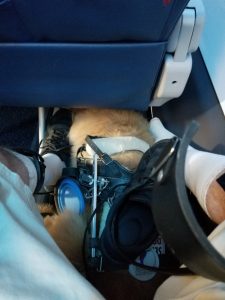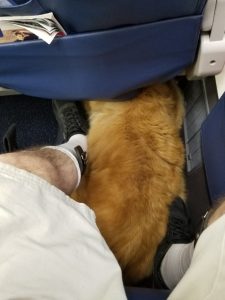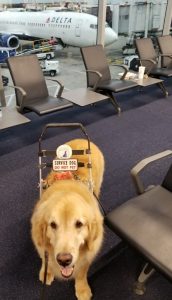Air travel with an assistance dog.
For many travelers, flying has become less and less enjoyable as the years have passed. Imagine the complications you may encounter when traveling with your assistance dog. Andrew and Motive took a trip to Atlanta in May, 2018. It was their first flight together as a service dog team. It was fraught with challenges despite the appropriate preparations. Air travel with an assistance dog requires planning, patience, and a great sense of humor.
Andrew did his research. He diligently checked airline regulations regarding traveling with Motive. Once he found the appropriate dates, times and fares he called the airlines to book his flights. He asked to speak to someone who could specifically help him with the requirements for travelling with an 85-pound Golden Retriever. He was assured that the seats he was assigned would all accommodate both he and Motive comfortably.

Off they went to the airport. Things went along smoothly until they boarded the plane at Orlando International Airport. This was the way they flew together to Atlanta.

The trip home was somewhat better as the flight attendant generously offered to stow Motive’s harness away for the flight which provided them both a few more inches of space.
On both flights Andrew was told by the flight attendants and gate agents that there was nothing they could do. Flights were full. They told him he could purchase an additional seat on a later flight to ensure Motive would have more space. What this airline designated as bulkhead seating provided less space that anyone could ever have imagined. Since they were both short flights, and he was on a tight schedule (and budget) Andrew and Motive made it work. They are the perfect team.
Andrew wanted to share some thoughts with everyone about his air travel experience from this recent trip so that others may benefit from his experiences (both good and bad).
Tips for Air Travel with an assistance dog:
Where do I begin?
► Review your rights under the ADA. It will help if you encounter someone who is not adequately trained in the accommodations provided under the ADA with regard to service dogs. Click here for ADA guidelines.
► Begin planning way in advance of your trip if at all possible. Not only will your airfare be less, but it provides ample opportunity to ask for assistance in selecting appropriate seating. Don’t reserve your seat(s) on line. Call the airline directly and ask to speak with a specialist who can assist disabled passengers traveling with a service dog.
► It is your responsibility to follow the policy of the airline you are flying with. Each airline has its own unique policy for what is required to travel with your assistance dog. READ THE FINE PRINT to avoid nasty surprises as you are boarding the plane.
► Bulkhead seating no longer means what it did years ago. Ask the reservationist what type of aircraft you will be flying on to ensure that your dog will have enough space to be comfortable during your flight.
While at the airport –
► Ask either the skycap or your ticket agent if there is a designated “relief station” for your dog to use within the airport. Remember to be a good citizen and clean up after your dog.
► If you are facing a long flight walk your assistance dog before boarding.
Passing through TSA –
► You should expect that TSA will pat down your service dog. They will check the vest, under the vest, collar, and harness (if you use one.) In some airports you will be asked to go through the metal detector leaving your dog in a “sit/stay” behind you as you go through. When the agent gives you the go ahead you will command your dog to “come” and proceed through the metal detector. You may be asked to remove the dogs harness.
 At the gate –
At the gate –
► Once you have arrived at the gate and check in with the gate agent remind them that you are traveling with a service dog. You will be able to board with the announcement of passengers needing assistance.
► If you wear leg braces you may be asked to remove them; if you are not asked to take them off you will more than likely be pat down. If you are in a wheelchair, you should expect a pat down and the use of a portable wand.
On the plane –
► If your seat does not provide ample space for you and your assistance dog or if you have difficulty negotiating your assigned seat with your AFO’s, cane, walker or dog’s harness you should immediately alert a flight attendant. There are many variables that will determine the outcome. If the plane isn’t full, you may be able to move, or the passengers next to you may be able to relocate. You may be told you need to purchase an additional seat for your dog, or you may have to position your assistance dog between your legs lengthwise so that your legs can straddle his torso. This is not the optimal way to fly. If you cannot come to an adequate resolution you may have to deplane and take a different flight.
► During take off and landing be sensitive to your assistance dog’s needs. His ears may pop, and he may be unfamiliar with the feeling. Having a chew toy may help alleviate his discomfort the way chewing gum and swallowing may help yours.
► When it’s time to leave the plane, give your assistance dog a few moments to stretch if he has been in a tight space before leaving the plane.

 At the gate –
At the gate – 